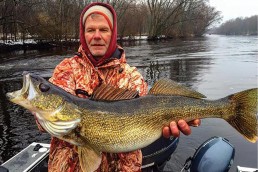River Walleyes: Go With the Flow
SHARE THIS POST
Walleyes are greatly effected by the change in water temperatures each season. By a adapting to these changes as Dave Csanda does, you will find yourself in the right place at the right time to catch more walleyes.
Walleyes are by nature river fish that have adapted to countless lake and reservoir environments. They are well-equipped to life in subtle to moderate current, and to quickly adapting to changes in current flow.
From fall through spring, increasing numbers of walleyes tend to collect below dams on major rivers throughout North America. The comparatively deep water of the scour holes formed below dams provides protection from being trapped beneath ice in shallower river stretches. Current funneling through dams delivers food to hungry walleyes below.
Most walleye anglers tend to only fish the deep hole area immediately below the dam. Walleyes may be there, but certainly not all the walleyes in a good fishery, which would overwhelm the available space and forage. Rather, think in terms of the first mile or so below a dam as being fall, winter and spring walleye territory.
Move downstream from a typical dam on a large river, and you’ll often find deep holes at river bends, current-deflecting wing dams and shoreline points, mid river shoals, bridge pilings, riprapped shorelines, backwater channels, tributary intersections, barge docks and a wealth of other manmade or natural structures that break the force of the current.
Early pre-spawn—32º-35º F
From fall through the first vestiges of spring, water temperatures are relatively stable, and current flow minimal. Virtually every location within the river is fair game for walleyes. Subtle current breaks are visible on the surface along shoreline structures, and large eddies of barely moving water occur below the dam—often accompanied by a small area of swifter flow exiting the dam itself. Walleyes are able to go pretty much everywhere they desire without having to fight strong current.
Most anglers vertically fish jig and minnow combos along current seams at the 8- to 18-foot levels, sometimes deeper. The entire river basin downstream of the scour hole may hold walleyes in the middle of the river, where they tuck tight to the bottom behind boulders, scattered wood, clam beds, rolling sand dunes and other current-deflecting structures.
Mid pre-spawn—35º-38º F
Rising water temperatures are typically accompanied by snowmelt and spring rains, with increased current and rising water swelling the river to its banks. As the center of the river becomes too swift for walleyes to easily navigate, they begin tucking tighter to shoreline areas providing protection from the flow. Current breaks and eddies are now smaller and more distinct.
You need to be on target with your presentations, typically jigging your jig right down the visible seam where current meets slack water, lifting it on and off bottom. Active fish will line up along the edge of the flow, awaiting a meal.
The front faces and even the tops of wing dams are fair game for walleyes. So are the fronts and backs of bridge pilings, riprap banks and tributary intersections downstream from the dam.
Are you enjoying this post?
You can be among the first to get the latest info on where to go, what to use and how to use it!
Late pre-spawn—38º-41º F
At this stage, rivers often overtop their banks, and water flows back into the adjacent woods, fields and backwaters, submerging vast areas of shoreline trees and vegetation. While current breaks tight to shore continue to draw walleyes, large numbers of fish penetrate flooded timber and vegetation.
Walleyes relatively near the flooded perimeter can still be caught with casting tactics, such as pitching small weedless jigs tipped with plastic tails, or slowly retrieving crankbaits or spinner jigs over, across and through the timber. Short underhanded pitches are en vogue.
In extreme flood conditions, move out of the main river and into flooded backwaters. Fish behind islands, up into creeks, even into boat harbors.
Spawn—42º-49º F
The same pretty much goes for the spawn period as it does for pre-spawn, with the added challenge that the fishing will, indeed, likely become tougher, since the fish have spawning on their minds, rather than eating.
Post-spawn—50º F plus
Once spawning is completed, walleyes begin deserting the general dam area, dispersing downstream to eventual summer areas. They go with the flow, following channels in backwaters, shorelines and creeks along the way.
Think in terms of moving fish, stopping here and there for brief periods before moving on again. Pods of walleyes temporarily hold in a spot, then leave, to be replaced by others later.
During this transition, flooded trees along the shoreline, closing dams in backwater channels, culverts and bridge pilings, and other temporary pit stops are good places to anchor and fish awhile, vertically dipping a jig or three-way rig as close as you dare to flooded cover without snagging too often. Expect occasional flurries as new groups of fish enter the area on their route downstream.
In a nutshell, spring river walleye fishing is a time of transitions, shifting fish locations and adapting presentations to the changing conditions.
Want to try a new location this season? You’ll find lots of suggestions in every issue of MidWest Outdoors, available the first full week of each month at the newsstand or by subscribing on our website.
MWO
SHARE THIS POST
You may also like...
Nothing found.
Did you enjoy this post?
You can be among the first to get the latest info on where to go, what to use and how to use it!
Dave Csanda
Dave Csanda has enjoyed 40 years in the fishing communications industry at In-Fisherman, Angling Edge and now, as editor of MidWest Outdoors. He is an inductee of both the Minnesota and National Fresh Water Fishing Halls of Fame.
